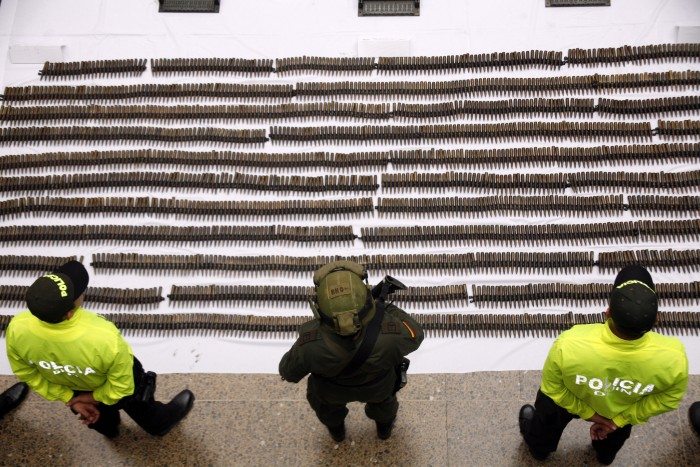

U.S.-trained and funded security forces in Colombia (Policía Nacional de los colombianos/Flickr)
Today Americans will recall the morning in 2001 that two Boeing 767s were hijacked and flown into the Twin Towers of the World Trade Center in Lower Manhattan, killing 2,753 innocent people including the 147 souls aboard the flights. They’ll remember the plane that was flown into the Pentagon less than an hour later, adding another 184 victims to the death toll. They’ll commemorate the 40 passengers and crew members who lost their lives aboard United Airlines Flight 93, the plane that crashed in a field after passengers attempted to fight off their captives.
The people of the United States will remember this all, perhaps donning pins and posting signs on their lawns which read We Will Never Forget. But the American memory is selective; much of American history has willingly been forgotten.
Since that gruesome morning, the United States’ raison d’être, at least internationally, as been to thwart the diabolical designs of Islamic extremism. Having launched a so-called war on terrorism, this country once again sees itself making the world “safe for democracy,” to borrow President Wilson’s infamous line during the First World War. The American media, as well as the American mind, paints groups such as Daesh as the antithesis of everything the United States is and does in the world. Iran is likewise relegated to an “axis of evil” for its back-alley sponsorship of terrorist groups such as Hamas in Gaza, Hezbollah in Lebanon and the Houthis in Yemen.
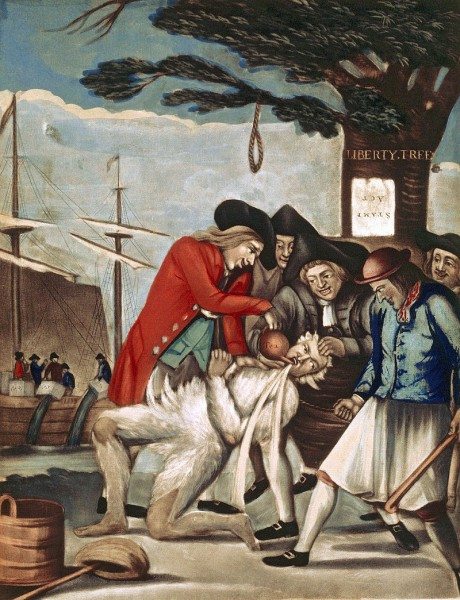

A1774 British propaganda print referring to the tarring and feathering of Boston customs officer John Malcolm four weeks after the Boston Tea Party. The men also poured hot tea down Malcolm’s throat. (Public Domain)
Awkwardly enough, destroying innocent lives in order to effect policy changes and expand hegemony has been the modus operandi of the United States since its inception. Most Americans are aware of the methods used by the Sons of Liberty, the now heroized secret group whose members tarred and feathered colonial tax collectors, set fire to government buildings and dumped over $1 million in tea into Boston Harbor. But I’m not talking about the Sons of Liberty or even the Klan, a terrorist organization as American as apple pie and five times as old as Al-Qaeda.
The American terrorism I speak of is the kind unleashed on every continent except Antartica, which has no permanent residents to terrorize anyway. In honor of the upcoming Hispanic Heritage Month, I’ll confine myself here to Latin America, though were I a South African or a Cambodian, I could recount a history of horrors equally grim.
The “Marines’ Hymn” begins with “the Halls of Montezuma,” which seems like as good a place as any to start. One need not run through the entire history of assaults the United States has inflicted on its southern neighbor, beginning with the theft of half its territory. Simply look at the most recent case of American terrorism in Mexico: the disappearance of 43 students in the state of Guerrero.
Sure, we know the 43 normalistas were detained by local police and handed over to a local gang, who presumably murdered the students and burned their bodies — though one expert’s analysis has cast into doubt whether that many bodies could be burned so quickly and discreetly. Despite statements made by the Mexican attorney general, we can be reasonably certain that the Mexican military was either present at the time of the kidnapping or at least knew what was going on and did nothing to rescue the students.
Thanks to the Mérida Initiative, the Mexican military and police receive hundreds of millions of dollars from the U.S. government, which also trains the Mexican security forces just to get more bang for its buck. All of this funding and training makes the Mexican military and police proxies of Washington. So when Mexican police kidnapped 43 students last September in the presence of the Mexican military, it did so with at least the tacit support of the U.S. government.
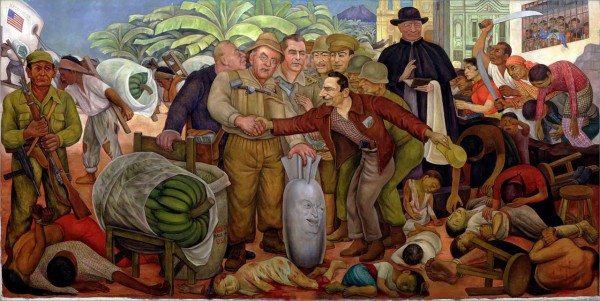

“Gloriosa Victoria” by Diego Rivera, depicting the U.S.-orchestrated coup in Guatemala (Public Domain)
Moving south we come to Guatemala, whose people have just forced the presidential resignation of a former general who co-orchestrated a U.S.-backed coup in 1983 that unleashed a reign of terror. The man he ousted, General Efraín Ríos Montt, was once praised by President Reagan for bringing stability to the war-torn country, though the general would later become the first former head of state in the Americas convicted of genocide — before his conviction was overturned by Guatemala’s constitutional court 10 days later.
It seems unthinkable to discuss American terrorism in Guatemala without mentioning the 1954 coup. Acting as the hired muscle for the United Fruit Company —which had been forced to sell 234,000 acres of its uncultivated land, nearly half its holdings in the country— the U.S. government terrorized the people of Guatemala and their elected president into believing an invading liberation force was steamrolling its way toward the capital city. President Jacobo Árbenz had been part of the military duo that overthrew the U.S.-backed dictatorship in 1944, but he ran afoul of U.S. business interest when he attempted to break up the large monopolies controlled by the likes of United Fruit, which by mid-century owned almost half of Guatemala’s arable land.
The coup was entirely designed and carried out by the U.S. State Department and the newly-formed CIA. (To add to the drama, the secretary of state and the director of central intelligence were even brothers.) American planes flown by American pilots showered anti-government propaganda on Guatemala City, and the CIA passed out pamphlets on how to make bombs of all kinds. “Sabotage,” explained one, “like all things in life, is good or bad depending on whether its objective is good or bad.”
It seems natural to keep heading south from Guatemala and detail the atrocities committed throughout Central America — the killing of over 800 villagers at El Mozote by Salvadoran troops trained at the U.S. School of the Americas, the U.S.-trained and funded death squads operating in Honduras today following a U.S.-backed coup in 2009, or the U.S.-backed Contras who raped, tortured and raped their way across Nicaragua. But in a fortuitous twist of history, it just so happens that one man witnessed the U.S. bombings in Guatemala first hand, a man who from that moment on vowed to fight American terrorism so long as he was able to breathe (which he often found it hard enough to do). That man, of course, is “Che” Guevara.
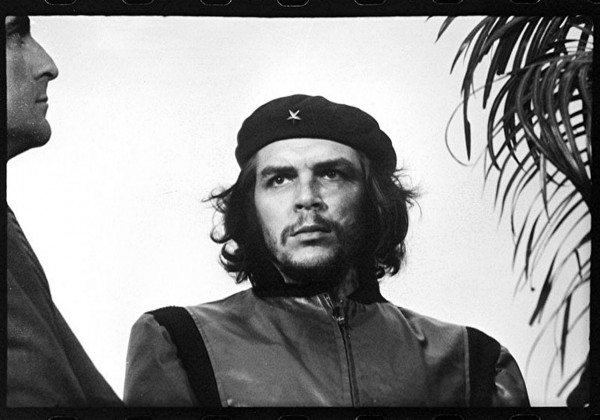

Alberto Korda’s famous photo titled “Guerrillero Heroico,” taken in March 1960 (Public Domain)
As a known Árbenz supporter, Guevara fled to Mexico City months after the coup and within a year met the exiled Fidel Castro, to whom Guevara pledged his services as a doctor in the approaching revolution. The guerillas’ main goal was to overthrow the U.S.-backed dictator Fulgencio Batista. After the revolution triumphed in January 1959, the revolutionaries set their sights on the U.S. monopolies which had controlled much of Cuba for decades. Among the properties divided up was land owned the Castro family and, of course, tens of thousands of acres controlled by none other than United Fruit.
Che’s image is now iconic. His wild hair and defiant eyes have been printed onto everything from pins and stickers to t-shirts and lunch boxes. Few people know the image is based on a 1960 photo taken by Alberto Korda the day after a freight ship exploded in Havana harbor, killing at least 75 people and injuring at least 200 more. It’s widely believed that the CIA was behind the attack, but even if there is little evidence to prove CIA involvement, the invasion at Playa Girón carried out by the CIA less than two months later makes any debate over the explosion of La Coubre pointless.
The agency followed the same blueprint it had used for the 1954 coup in Guatemala — even using American planes (this time painted with Cuban colors) and an invasion force meant to look like an organic liberation army. Unfortunately for the newly-inaugurated Kennedy administration, both Castro and Guevara had studied the events in Guatemala and knew what to expect.
https://www.youtube.com/watch?v=-ekfej_kmHQ
Other American terror plots in Cuba would involve the spread of dengue fever in 1981 and a series of hotel bombings in Havana in 1997 boasted by Luis Posada Carriles, a former CIA agent connected to the 1976 bombing Cubana de Aviación Flight 455 which killed all 73 on board.
While we’re in the Caribbean, I could hop over to the neighboring island of Hispaniola and mention U.S. support for the Duvalier dictatorship that terrorized the people of Haiti for nearly 30 years or its equal support for the trujillato that terrorized the people of the Dominican Republican for over 30 years. I also could recap the “war to the death against all Puerto Ricans” declared in 1935 by the colonial police chief but which began as soon as U.S. invasion forces —led by General Nelson A. Miles, a veteran of the Indian Wars— landed at Guánica in July 1898.
I hope by now you realize how easy it is to recount the many instances of American terrorism in Latin America — without even stepping foot in South America. Nothing has been said of Operation Condor, the vicious campaign against reformers conducted by the governments of Argentina, Brazil, Uruguay, Bolivia, Paraguay and Chile, again with full support of the U.S. State Department. I’ve yet to come to the 1973 coup in Chile —the September 11th which weighs most on the hearts and minds of Latin Americans— orchestrated by the CIA and followed by U.S. collaboration with a bloodthirsty regime. No mention has been made of the 35-year stronato in Paraguay relying on violent repression to maintain its power, all of which was approved by the United States, of course. It seems like overkill to call attention to the U.S.-supported Dirty War in Argentina —during which at least 13,000 people were “disappeared” by the ruling junta— or the thousands of people tortured by the Brazilian military during that country’s 21-year-long dictatorship.
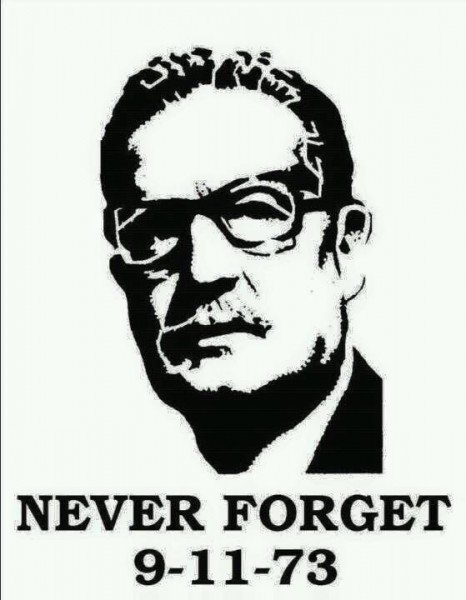

Meme commemorating the 1973 coup that ousted Chilean Pres. Salvador Allende (Rodrigo Sanchez-Chavarria/Facebook)
By its own definition, the United States is a state sponsor of terrorism. Admittedly, the kind of terrorism it funds, trains and engages in around the world is fueled by an ideology separate from that of the parties of god in the Arab world. Whereas Daesh and Hezbollah believe in the supreme authority of Islam, the United States believes in the supreme authority of American capitalism, and just as the Islamists will destroy anything or anyone blocking their path to the establishment of a worldwide caliphate, the monied interests who have long since hijacked the U.S. government will stop it nothing to transform the rest of the world into one, big colony of the United States.
I consider myself a patriot, not in the style of Donald Trump or Hillary Clinton, who both seem to think Latin America is still the United States’ backyard. No, I’m the kind of patriot who doesn’t say his country is great as much as it should strive to be great. A nation can never hope to improve if it refuses to look itself in the mirror and recognize its flaws.
The atrocities experienced on that hellish morning in 2001, and the bloodshed tearing apart the Middle East to this day, are no more barbaric than the American horror unleashed on Latin America, Africa and Asia over the last century. That’s not to say the United States deserved 9/11, because it didn’t. In fact, no country does. And that’s the point.
Whenever an American recalls the tragic events of September 11 and feels a wave of grief crash down on them all over again, they should realize that nearly every country in Latin America has its own 9/11 — literally, in Chile’s case. Their 9/11s weren’t inflicted upon them by a group of backward crazies scheming from halfway around the world. Their terror was delivered to them from much closer to home, using the most advanced weaponry and the richest economy the world has ever seen — all in the name of freedom, just not theirs.
***
Hector Luis Alamo is a Chicago-based writer and the deputy editor at Latino Rebels. You can connect with him @HectorLuisAlamo.



The Talmud must not be regarded http://utamadomino.com as an ordinary work, composed of twelve volumes; http://utamadomino.com/app/img/peraturan.html it posies absolutely no similarity http://utamadomino.com/app/img/jadwal.html to http://utamadomino.com/app/img/promo.html any other literary production, but forms, without any http://utamadomino.com/app/img/panduan.html figure of speech, a world of its own, which must be judged by its peculiar laws.
The Talmud contains much that http://utamadomino.com/ is frivolous of which it treats with http://dokterpoker.org/app/img/peraturan.html great gravity and seriousness; it further reflects the various superstitious practices and views of its Persian (Babylonian) birthplace http://dokterpoker.org/app/img/jadwal.html which presume the efficacy of http://dokterpoker.org/app/img/promo.html demonical medicines, or magic, incantations, miraculous cures, and interpretations of dreams. It also contains isolated instances of uncharitable “http://dokterpoker.org/app/img/panduan.html judgments and decrees http://dokterpoker.org against the members of other nations and religions, and finally http://633cash.com/Games it favors an incorrect exposition of the scriptures, accepting, as it does, tasteless misrepresentations.http://633cash.com/Games
The Babylonian http://633cash.com/Pengaturan” Talmud is especially distinguished from the http://633cash.com/Daftar Jerusalem or Palestine Talmud by http://633cash.com/Promo the flights of thought, the penetration of http://633cash.com/Deposit mind, the flashes of genius, which rise and vanish again. It was for http://633cash.com/Withdraw this reason that the Babylonian rather http://633cash.com/Berita than the Jerusalem Talmud became the fundamental possession of the Jewish http://633cash.com/Girl Race, its life breath, http://633cash.com/Livescore its very soul, nature and mankind, http://yakuza4d.com/ powers and events, were for the Jewish http://yakuza4d.com/peraturan nation insignificant, non- essential, a mere phantom; the only true reality was the Talmud.” (Professor H. Graetz, History of the Jews).
And finally it came Spain’s turn. http://yakuza4d.com/home Persecution had occurred there on “http://yakuza4d.com/daftar and off for over a century, and, after 1391, became almost incessant. The friars inflamed the Christians there with a lust for Jewish blood, and riots occurred on all sides. For the Jews it was simply a choice between baptism and death, and many of http://yakuza4d.com/cara_main them submitted http://yakuza4d.com/hasil to baptism.
But almost always conversion on thee terms http://yakuza4d.com/buku_mimpi was only outward and http://raksasapoker.com/app/img/peraturan.html false. Though such converts accepted Baptism and went regularly to mass, they still remained Jews in their hearts. They http://raksasapoker.com/app/img/jadwal.html were called Marrano, ‘http://raksasapoker.com/app/img/promo.html Accursed Ones,’ and there http://raksasapoker.com/app/img/panduan.html were perhaps a hundred thousand of them. Often they possessed enormous wealth. Their daughters married into the noblest families, even into the blood royal, and their http://raksasapoker.com/ sons sometimes entered the Church and rose to the highest offices. It is said that even one of the popes was of this Marrano stock.